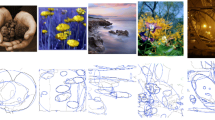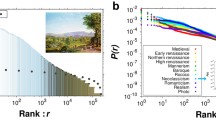Abstract
This study is aimed at exploring the ability of complexity-based metrics to distinguish between paintings and photographs. The proposed features resort to edge detection, compression and entropy estimate methods that are highly correlated with artwork complexity. Artificial neural networks based on these features were trained for this task. The relevance of various combinations of these complexity metrics is also analyzed. The results of the current study indicate that different estimates related to image complexity achieve better results than state-of-the-art feature sets based on color, texture and perceptual edges. The classification success rate achieved is 94.82% on a dataset of 5235 images.








Similar content being viewed by others
References
Aks DJ, Sprott JC (1996) Quantifying aesthetic preference for chaotic patterns. Empir Stud Arts 14(1):1–16
Arnheim R (1954) Art and visual perception: a psychology of the creative eye. Univ of California Press, California
Arnheim R (1966) Towards a psychology of art/entropy and art? An essay on disorder and order. The Regents of the University of California, California
Athitsos V, Swain MJ, Frankel C (1997) Distinguishing photographs and graphics on the world wide web. Content-Based Access of Image and Video Libraries, 1997. Proceedings. IEEE Workshop on, IEEE, pp 10–17
Birkhoff GD (1933) Aesthetic measure. Mass, Cambridge
Blum A (1992) Neural networks in C++: an object-oriented framework for building connectionist systems. Wiley, New York
Canny J (1986) A computational approach to edge detection. IEEE Trans Pattern Anal Mach Intell 8(6):679–698
Cutzu F, Hammoud R, Leykin A (2003) Estimating the photorealism of images: distinguishing paintings from photographs. In: Computer Vision and Pattern Recognition, 2003. Proceedings. 2003 IEEE Computer Society Conference on, IEEE, 2: II–305
Cutzu F, Hammoud R, Leykin A (2005) Distinguishing paintings from photographs. Comput Vision Image Underst 100(3):249–273
Datta R, Joshi D, Li J, Wang JZ (2006) Studying aesthetics in photographic images using a computational approach. In: Leonardis A, Bischof H, Pinz A (eds) Computer Vision – ECCV 2006. Lecture notes in computer science, vol 3953. Springer, Berlin, Heidelberg, pp 288–301
Eysenck HJ (1941) The empirical determination of an aesthetic formula. Psychol Rev 48(1):83
Eysenck HJ (1942) The experimental study of the’good gestalt’? A new approach. Psychol Rev 49(4):344
Fisher Y (1994) Fractal image compression. Fractals 2(03):347–361
Forsythe A, Nadal M, Sheehy N, Cela-Conde CJ, Sawey M (2011) Predicting beauty: fractal dimension and visual complexity in art. Br J Psychol 102(1):49–70
Greenfield G, Machado P (2009) Simulating artist and critic dynamics—an agent-based application of an evolutionary art system. In: Dourado A, Rosa AC, Madani K (eds) IJCCI 2009—Proceedings of the international joint conference on computational intelligence. INSTICC Press, Funchal, Madeira, pp 190–197
Huttenlocher DP, Klanderman GA, Rucklidge WJ (1993) Comparing images using the hausdorff distance. IEEE Trans Pattern Anal Mach Intell 15(9):850–863
Kohavi R (1995) A study of cross-validation and bootstrap for accuracy estimation and model selection. IJCAI Morgan Kaufmann, Burlington, pp 1137–1145
Machado P, Cardoso A (1998) Computing aesthetics. In: de Oliveira FM (ed) Advances in artificial intelligence. SBIA 1998. Lecture notes in computer science, vol 1515. Springer, Berlin, Heidelberg, pp 219–228
Machado P, Cardoso A (2002) All the truth about nevar. Appl Intell 16(2):101–118
Machado P, Romero J, Santos ML, Cardoso A, Manaris B (2004) Adaptive critics for evolutionary artists. In: Raidl GR et al (eds) Applications of evolutionary computing. EvoWorkshops 2004. Lecture notes in computer science, vol 3005. Springer, Berlin, Heidelberg, pp 437–446
Machado P, Romero J, Manaris B (2008) Experiments in computational aesthetics. In: The art of artificial evolution, Springer, pp 381–415
Machado P, Romero J, Nadal M, Santos A, Correia J, Carballal A (2015) Computerized measures of visual complexity. Acta Psychol 160:43–57. doi:10.1016/j.actpsy.2015.06.005, http://www.sciencedirect.com/science/article/pii/S0001691815300160
Manaris B, Purewal T, McCormick C (2002) Progress towards recognizing and classifying beautiful music with computers-midi-encoded music and the Zipf-Mandelbrot law. SoutheastCon, 2002. Proceedings IEEE, IEEE, pp 52–57
Manaris B, Romero J, Machado P, Krehbiel D, Hirzel T, Pharr W, Davis RB (2005) Zipf’s law, music classification, and aesthetics. Comput Music J 29(1):55–69
Manaris B, Roos P, Machado P, Krehbiel D, Pellicoro L, Romero J (2007) A corpus-based hybrid approach to music analysis and composition. In: Proceedings of the 22nd National Conference on Artificial Intelligence, Vol 1, AAAI Press, AAAI’07, pp 839–845
Meier NC (1942) Art in human affairs; an introduction to the psychology of art. McGraw-Hill, New York
Moles AA (1957) Théorie de l’information et perception esthétique. Rev Philos de la France et de l’Étranger 147:233–242
Nadal Roberts M (2007) Complexity and aesthetic preference for diverse visual stimuli. Ph.D. thesis, Universitat de les Illes Balears
Powers DM (1998) Applications and explanations of Zipf’s law. In: Proceedings of the Joint Conferences on New Methods in Language Processing and Computational Natural Language Learning, Association for Computational Linguistics, pp 151–160
Rigau J, Feixas M, Sbert M (2005) An information-theoretic framework for image complexity. In: Proceedings of the First Eurographics conference on Computational Aesthetics in Graphics. Visualization and Imaging, Eurographics Association, pp 177–184
Romero J, Machado P, Carballal A, Osorio O (2011) Aesthetic classification and sorting based on image compression. In: Di Chio C et al (eds) Applications of evolutionary computation. EvoApplications 2011. Lecture notes in computer science, vol 6625. Springer, Berlin, Heidelberg, pp 394–403
Romero J, Machado P, Carballal A, Correia J (2012a) Computing aesthetics with image judgement systems, Springer, Berlin, pp 295–322. doi:10.1007/978-3-642-31727-9_11.
Romero J, Machado P, Carballal A, Santos A (2012b) Using complexity estimates in aesthetic image classification. J Math Arts 6(2–3):125–136
Rumelhart DE, Hinton GE, Williams RJ (1988) Neurocomputing: foundations of research. MIT Press, Cambridge. chap Learning representations by back-propagating errors, pp 696–699
Salingaros NA, West BJ (1999) A universal rule for the distribution of sizes. Environ Plan B 26:909–924
Saunders R, Gero JS (2001) Artificial creativity: a synthetic approach to the study of creative behaviour. Computational and cognitive models of creative design V, Key Centre of Design Computing and Cognition. University of Sydney, Sydney, pp 113–139
Schiffmann W, Joost M, Werner R (1994) Optimization of the backpropagation algorithm for training multilayer perceptrons. Technical report, University of Koblenz, Institute of Physics, Rheinau
Sobel I (1990) An isotropic 3 \(\times\) 3 image gradient operator. Mach Vision Three Dimens Sci 3:376–379
Spehar B, Clifford CW, Newell BR, Taylor RP (2003) Universal aesthetic of fractals. Comput Gr 27(5):813–820
Svangård N, Nordin P (2004) Automated aesthetic selection of evolutionary art by distance based classification of genomes and phenomes using the universal similarity metric. In: Raidl GR et al (eds) Applications of evolutionary computing. Lecture notes in computer science, vol 3005. Springer, Berlin, Heidelberg, pp 447–456
Taylor RP, Micolich AP, Jonas D (1999) Fractal analysis of pollock’s drip paintings. Nature 399(6735):422–422
Voss RF, Clarke J (1978) “1/f noise” in music: music from 1/f noise. J Acoust Soc Am 63:258
Zipf GK (1949) Human behavior and the principle of least effort. Addison-Wesley press, Boston
Acknowledgements
We are very grateful for the reviewers suggestions. This work was supported by the General Directorate of Culture, Education and University Management of Xunta de Galicia (Ref. GRC2014/049) and the European Fund for Regional Development (FEDER) in the European Union, the Portuguese Foundation for Science and Technology in the scope of project SBIRC (Ref. PTDC/EIA EIA/115667/2009), Xunta de Galicia (Ref. XUGA - PGIDIT - 10TIC105008-PR) and the Spanish Ministry for Science and Technology (Ref. TIN2008-06562/TIN).
Author information
Authors and Affiliations
Corresponding author
Rights and permissions
About this article
Cite this article
Carballal, A., Santos, A., Romero, J. et al. Distinguishing paintings from photographs by complexity estimates. Neural Comput & Applic 30, 1957–1969 (2018). https://doi.org/10.1007/s00521-016-2787-5
Received:
Accepted:
Published:
Issue Date:
DOI: https://doi.org/10.1007/s00521-016-2787-5




